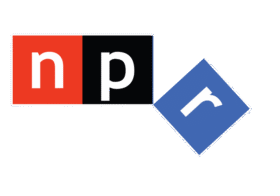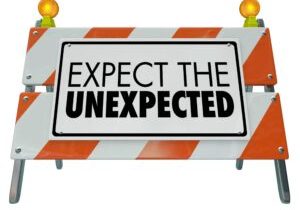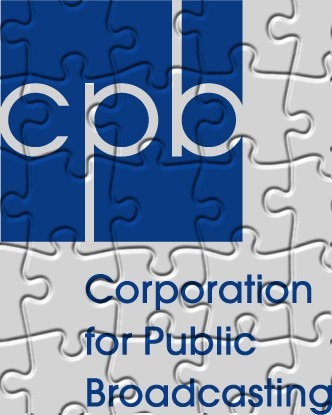
Those of us who have been active in the broadcast radio business have gotten used to tumult, instability, and even surprises. You’ve heard the phrase, “where the only constant is change”—it may as well have been coined for the radio industry, especially here in the U.S.
From deregulation and consolidation in the 1990s to the whipsaw effect of The Great Recession and COVID just five years ago, the world of radio has seemingly been through it all.
But when Congress passed the recission bill last month effectively shuttering the Corporation for Public Broadcasting, public radio’s funding arm, it sent a shock wave throughout the industry. Now of course, if you’ve been working in public radio or television, you’re likely feeling the effects of unstable economic times coupled with this defunding legislation. Many public media organizations have spent the last many months, spreadsheets open, deep in conversation about how to cut back on expenses without doing harm to the operation as a whole.
This brash move by Congress deeply impacted public media in general, and hundreds of public radio stations specifically—especially those mostly in smaller communities who were dependent on CPB funding. A story in Nieman Lab last month last week described what many of these stations are enduring, focusing on how indigenous radio stations in Alaska are faring since the demise of CPB.
In “How tribal radio stations are preparing for a future without the Corporation for Public Broadcasting,” Neel Dhanesha discussed the effects of defunding, including in some cases, shutdowns. For many remote stations in these areas, recission may force even more stations off the air before this year is out.
In larger markets, public radio stations now find themselves having to make cutbacks on staff and other expenses. In this process, they are trying to determine the best outcomes—operating pre-emptively where they get out ahead of the economic stress by terminating employees, as well as sunsetting projects like podcasts. Other will wait to make cuts until they actually have to do something. There are no right or wrong answers here. But suffice it to say, most are dealing with conditions and decisions they’ve never had to make during careers that might span decades.
This shifting of public radio’s tectonic plates infrastructure is a stark symbol that stations and their parent organizations are going to have to “re-evaluate everything” in order to come out of this thing healthy and whole. What was once one of the most stable corners in all of radio, the public media system is reeling, searching for leadership, direction, and frankly, a way out.
Whether it’s content creation, membership, staffing and organization, underwriting, funding, news, music, or even consolidation, everything should be on the table at this point on the curve. Of course, just the process of discussion and debate are off-putting to many, especially those who assumed public radio and television would always be there for them—that someone would dutifully come into work every morning to fire up the transmitter and get the new broadcast day off to a strong start.
But even the simple things can’t be taken for granted in 2025. And like it or not, “re-evaluate everything” isn’t just a fascinating idea, it is likely the best path public radio and television have that can facilitate a return to power within a period of great change, not just for the public media sector, but for all of broadcasting and media.
A recent New York Times story—“The Race to Rescue PBS and NPR Stations”—does a good job of laying out what’s at stake, and how foundations are writing big checks that hope to plug some of public media’s budgetary holes. In fact, Richard J. Tofel, former president of ProPublica, suggests foundation funds are already being reduced and that public media executives would be wise to get more creative and innovative when it comes to funding and deficits. You can read his Substack article from last month here.
What this story omits is that the target for this fund was originally $100 million, now halved. And that by raising $50 million once it somehow seeks to “bridge” the loss of $250 million every year.www.nytimes.com/2025/08/19/b…
— Richard Tofel (@dicktofel.bsky.social) 2025-08-19T10:22:53.966Z
As someone who’s no stranger to crisis management and turnaround strategies, a public radio recovery in the near future will be challenging. First of all, despite the presence of well-known organizations in the space—including NPR and PBS, CPB (pre its demise), Greater Public (membership, funding, revenue), PMCC (the Public Media Content Collective, formerly the Public Radio Program Directors association), and others like the Station Resource Group, there is no “one voice” organization representing public radio and acting as a clearing house for new initiatives that keep moving the system forward.
Public radio is a series of media fiefdoms, often led by individual non-profits or universities. Not dissimilar to existing commercial radio companies, they all march to the beat of their own percussion sections—for better or for worse.
It would behoove public radio at this tumultuous fork in the road to work together, at the least regionally, to craft strategies and tactics that serve their organizations well.
The good news is that there’s plenty of research that can inform these strategies. In City Square’s massive RUN project (Research Unmet Needs), all the statistical bread crumbs lead to an emphasis on local (news), as well as community “eye contact.”
This is the moment to “meet new friends” by getting out of the comfy, familiar pubic radio “snow globe” confines—(already springing a leak or two) and truly interface and connect with local communities. You can make the case that the role of the station general managers has now been reordered, encouraging these leaders to become active parts of the local business community (serving on boards, supporting and showing up at major events in the metro, and amping up community presence).
Clearly, this is a time for experimentation and innovation. Paul and I have long spoken about the need for public radio to get beyond “pledge drives,” an effective but shopworn fundraising tool. As we have seen in our association with Children’s Miracle Network, an arsenal of concepts that all have an end goal of raising more funds should be at the center of public radio’s efforts.
Even merch programs can be difference makers. Our friends at Buffalo Toronto Public Media recently unveiled a entire new line of T-shirts and other logowear with messages that exude attitude and a strong sense of being in the moment:

You can check out their designs or support their mission here.
Public radio operators are looking for answers, as well as for innovations that work. Fortunately, one of the last big public radio conferences of the year takes place next week in Salt Lake City. The Public Media Content Collective’s Content Conference takes flight with the hope of providing direction and putting together the puzzled pieces.
I have the honor of once again of unveiling this year’s new Public Radio Techsurvey, designed to help provide professionals in the system with a path forward. In this year’s 17th annual survey, we’re providing guidance on myriad topics, tactics, and perceptions. The goal is to use this data as a foundation for action.
year’s 17th annual survey, we’re providing guidance on myriad topics, tactics, and perceptions. The goal is to use this data as a foundation for action.
A truly interesting thing happened when this year’s study was fielded earlier in the summer. We always schedule these massive PRTS studies for June/July and this year was no exception. But it turned out these survey dates overlay perfectly on top of the recission event, providing a unique glimpse at public radio’s core audience while the system was in the process of being defunded. Below, Chris Brunt put together the schematic that shows the alignment of PRTS 2025 with the major events impacting public radio:
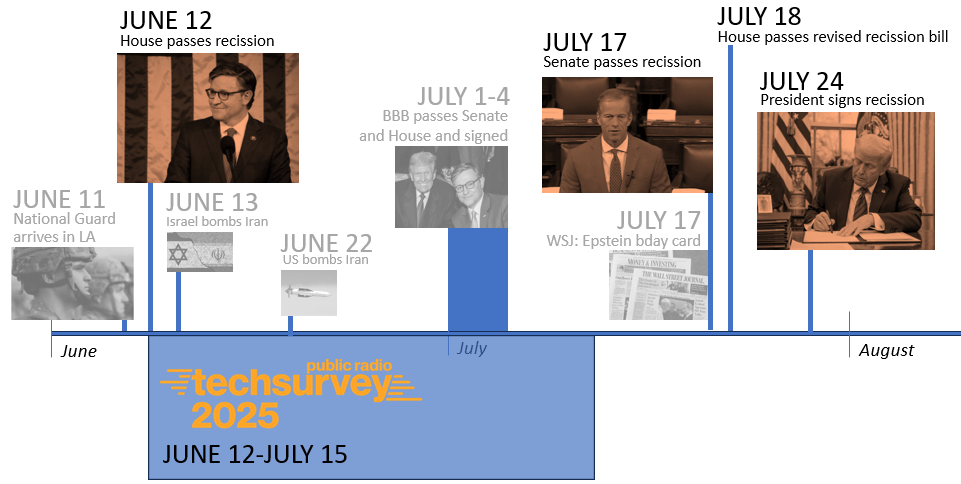
That’s right—PRTS 2025 will be a fascinating snapshot of the emotional state of public radio’s most loyal listeners while the system was in the process of being decimated. There is a host of new questions in this survey, as well as deep dives into fundraising, community events and promotions, news content and coverage, and perhaps most importantly, the audience’s state of mind as this turbulent crossroads for public media.
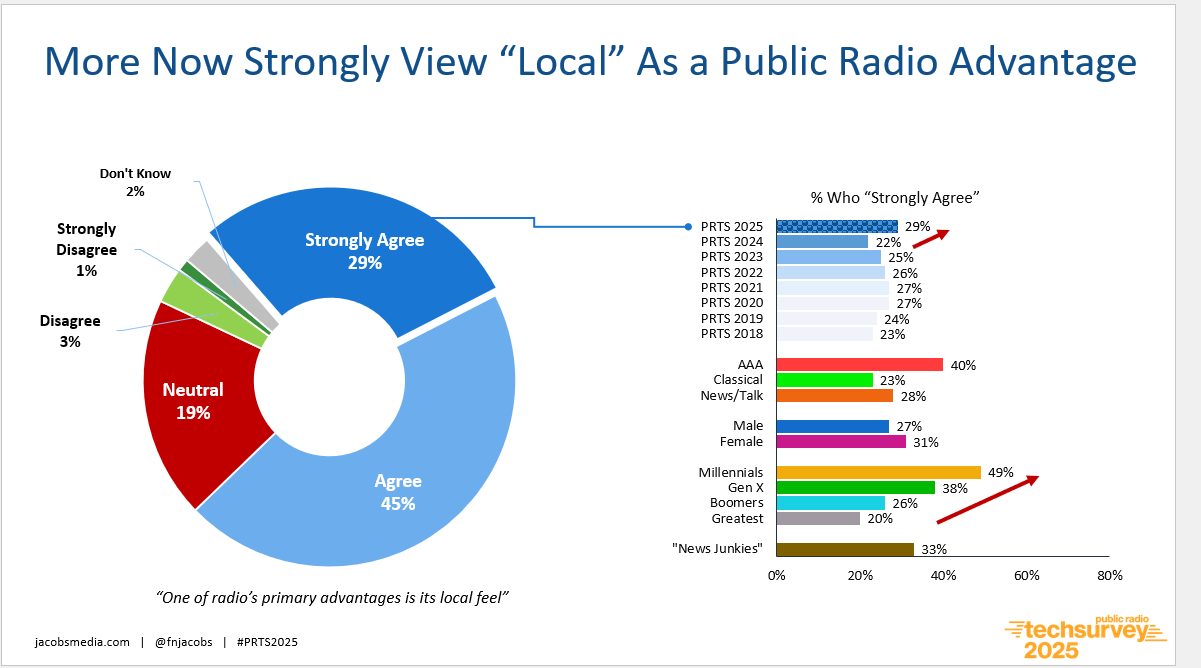
In addition, my presentation on Thursday morning, August 28, will be reformatted to meet the current crisis at end—a guide to helping public media execs devise a path forward. To ensure the most strategists can see it, executive director Abby Goldstein will be live streaming my session (as well as several others). There is no fee to sit in on these sessions. Registration info is here.
And to sign up for my PRTS 2025 specifically, use this link.
The last third of 2025 promises to be a wild ride for all of radio, but public radio occupies a rarefied air moment in time as a result of this Congressional action. Every player in the system—managers, programmers, journalists, administrators, board members, presenters, fundraisers, underwriters, and researchers may look back at the remainder of this year as the moment when it all changed.
And let’s be real. Research isn’t going to “fix” this. But it can be effective in helping guide teams doing the heavy lifting. If we can be of assistance in interpreting the data and/or prioritizing actiion steps, please don’t hesitate to call on us. We are proud of this body of research and the stories it tells. But it only is meaningful if you use and benefit from it.
At Jacobs Media, we’re prepared to do what it takes to provide clarity, guidance, and strategic thinking.
Hope to see you in SLC or online next week for my PRTS 2025 presentation.
Originally published by Jacobs Media

